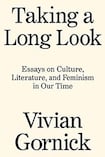
A year into the pandemic, brutal stories are emerging about how the associated lockdowns and school closures have disproportionately affected women. In WhatsApp groups, on social media and in the press, women have been speaking out about the almost unmanageable toil of homeschooling and caring for children while schools and childcare facilities are closed.
Those women come to mind while reading Taking a Long Look, a new collection of essays from the American writer Vivian Gornick. Best known for her 1987 memoir Fierce Attachments, Gornick (85) is a shrewd, droll and avowedly feminist essayist and critic. These previously published writings, collected in reverse chronological order (from the late 2010s to early 1970s), offer a fascinating insight into what has been achieved and what has been lost during those five decades.
When Gornick considers the power of feminist consciousness-raising groups in one essay, first published in the New York Times in 1971, the women she encounters are peeved. What’s striking to a reader a full 50 years later is how familiar their complaints are. One woman explains that although she and her husband work the same hours in the same factory, it is she who is expected to do the dishes each evening. A group in Manhattan discuss sexual harassment in the workplace and the way shouting men in the street demand smiles and politeness.
Progress
While promoting the book, Gornick observed: “People were lulled into thinking more progress had been made than had actually been made. And then #MeToo woke us all up to exactly how far we’ve come – which is nowhere near far enough.”
Gornick knows that her generation of feminists are indebted to the 19th-century feminists, worrying at one point that nothing has been achieved since Susan B Anthony’s day. Ultimately, though, she sees that the 1970s movement offered a new viewpoint to millions of women, asserting that “the consciousness-raising group of today is the true second front of feminism”. A 2021 reader thinks about how the world changes and how it does not; about what is owed to previous and subsequent generations.
We think about how a writer changes, too. Gornick is a woman, she is Jewish and she is a New Yorker. Her identity is always felt in her essays – but it is in her earlier work that she is at her most boisterous. In 1976’s exasperatedly entitled Why Do These Men Hate Women?, she lambasts Norman Mailer and Philip Roth for the misogyny she sees in their work. Of Roth, she writes unsparingly: “With each book one sees the horror of a writer who has failed to mature personally, has contrived unsuccessfully to make of that failure a modern myth, and recedes yearly into literary self-delusion.”
Her presence on the page is less overt in the literary criticism published since 1999. Reading her crisp, incisive prose, there is no doubt about how she feels about the work of such canonical figures as Herman Melville, Primo Levi and Hannah Arendt, but she becomes less incendiary over the years.
Politics in everyday life
Two personal essays about life in New York – Bobby’s Salon and On the Bus, written in the early 2000s – allow for a beautiful ambiguity. With humour and compassion, she allows us access to places (a run-down hair salon and a Greyhound bus) only known to New Yorkers. Here is the experience of the oppressed, the cash-strapped, the troubled, the ordinary – and it is captivating. Through Gornick, we observe and understand the undertow of politics in an individual’s everyday life; we glimpse pain, loneliness and hopefulness.
In the book’s introduction, Gornick writes “of the long apprenticeship of a writer who, in the act of making naked use of her own undisguised experience, has taught herself to value writing that serves the story rather than writing that imposes itself on the story”. Here we have exactly that.
This intelligent, sometimes provocative, collection of essays will send you back to the bookshop or down a Google rabbit hole. Any gaps in your knowledge will be exposed mercilessly by Gornick – and there will likely be writers of whom you have never heard. A 2017 essay on Kathleen Collins, a black film-maker and writer who died at 46 before her short stories were ever published, is particularly affecting. Collins’s immense talent is made clear without hyperbole, with Gornick noting that the publication of her work long after her death, “during a period of flaring racism”, means the stories are “on the one hand oddly original, on the other painfully familiar”.
Injustice is a stubborn scourge: Vivian Gornick reminds us of that, whether she’s writing from the 1970s or today.










